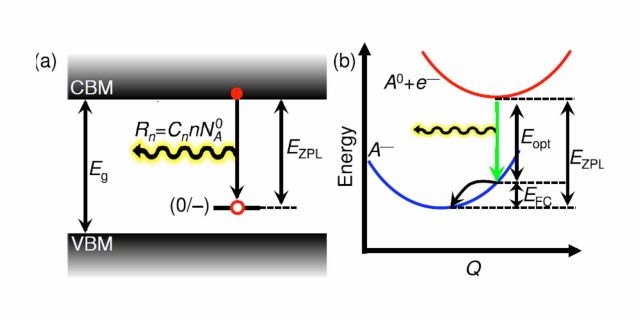Loss Mechanisms in Light Emitters
Solid-state light emitters are energy-efficient solutions for lighting and displays. We aim to make them even more efficient.
Auger recombination and efficiency droop in nitride light emitters
Light-emitting diodes (LEDs) are efficient, non-toxic, and long-lasting white light sources that can replace incandescent and fluorescent light bulbs for general lighting applications. However, existing nitride-based LEDs show a dramatic efficiency decrease (so-called "droop") when operated at high currents. The origins of the efficiency loss were widely debated. Over the years, we have developed computational techniques to be able to calculate these nonradiative losses completely from first principles. We were able to identify that the droop results from Auger recombination, a three-carrier nonradiative recombination mechanism that dominates over the radiative process at high carrier densities. [1] Contrary to other optoelectronic semiconductors, Auger recombination in the nitrides occurs via indirect processes, mediated by electron-phonon coupling and alloy scattering. Identifying this loss mechanism suggested device designs that reduce its impact and was an important step towards the engineering of efficient high-power LEDs. [2]
Defect-assisted Shockley-Read-Hall recombination
We are exploring the microscopic origins of Shockley-Read-Hall (SRH) recombination in nitride light emitters. Defect-assisted recombination limits the maximum internal quantum efficiency of devices. A SRH recombination process consists of two carrier capture events: electron capture and hole capture. Thus, the study of carrier capture processes is a prerequisite to the study of SRH recombination. We have developed a practical first-principles methodology to calculate carrier capture coefficients based on parameters from hybrid functional calculations. These have been benchmarked with available experimental data for selected defects in GaN and ZnO and have demonstrated excellent agreement. We have applied the methodology to identify defects in nitride semiconductors that are most detrimental to light emission. [1,2,3]
Photoluminescence lineshapes
Though nonradiative transitions result in loss from Shockley-Read-Hall recombination, the experimental study of radiative transitions provides a lot of useful information about defect geometries, vibrational properties, etc. However it is often difficult to determine the chemical nature of defects responsible for a given experimental observation. Therefore, the ability to determine the luminescence properties of defects from first principles is a powerful tool for defect identification. We have developed a first-principles methodology to calculate luminescence lineshapes for defects with very strong electron-phonon coupling and extended it to treat the more complicated situation of defects with moderate electron-phonon coupling, which have lineshapes with more structure, and often many contributing phonon frequencies. We have benchmarked these techniques and now are using them to explore various defects in nitride materials and beyond. We have also developed a methodology to calculate radiative recombination rates. [1,2]


